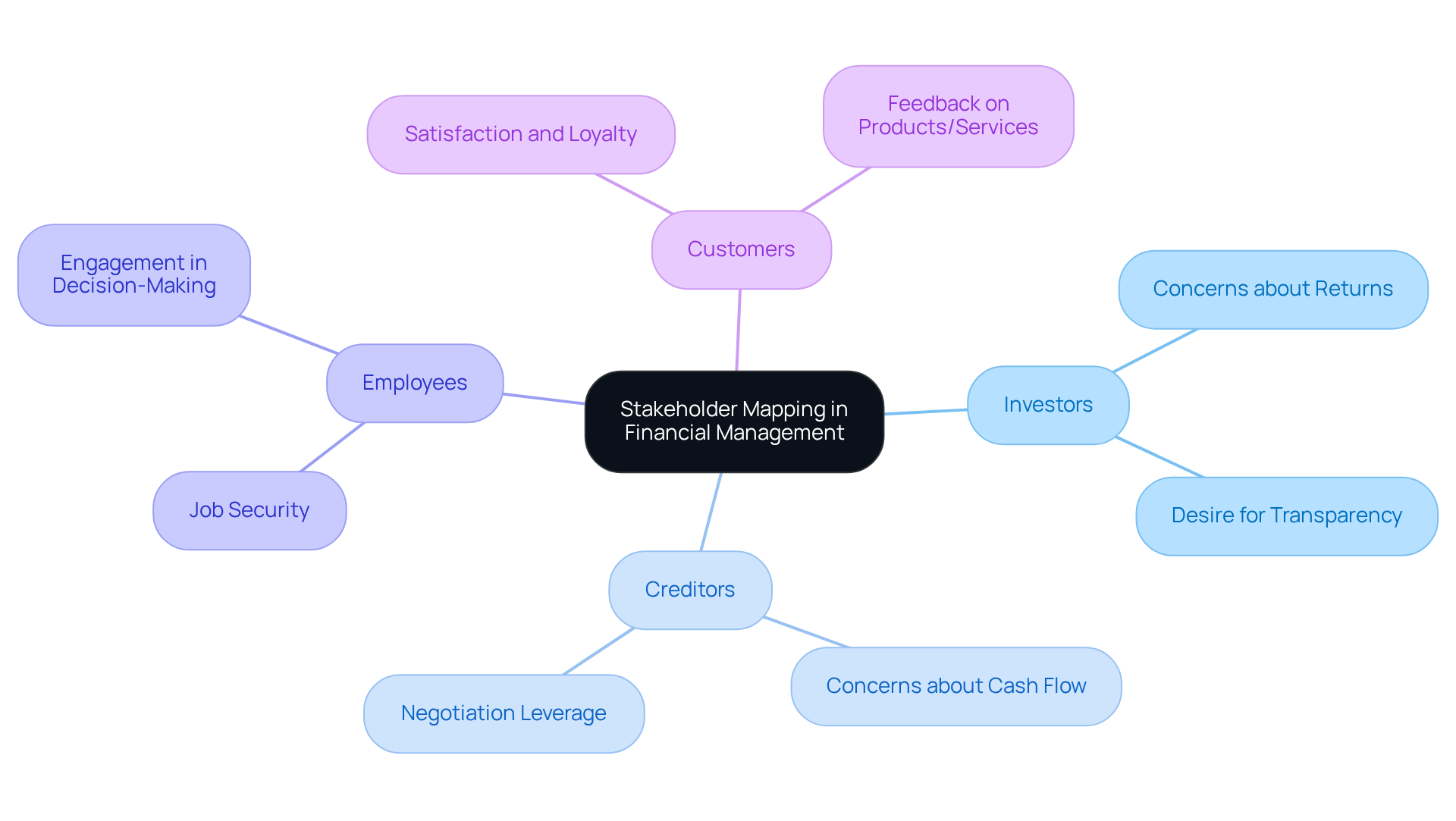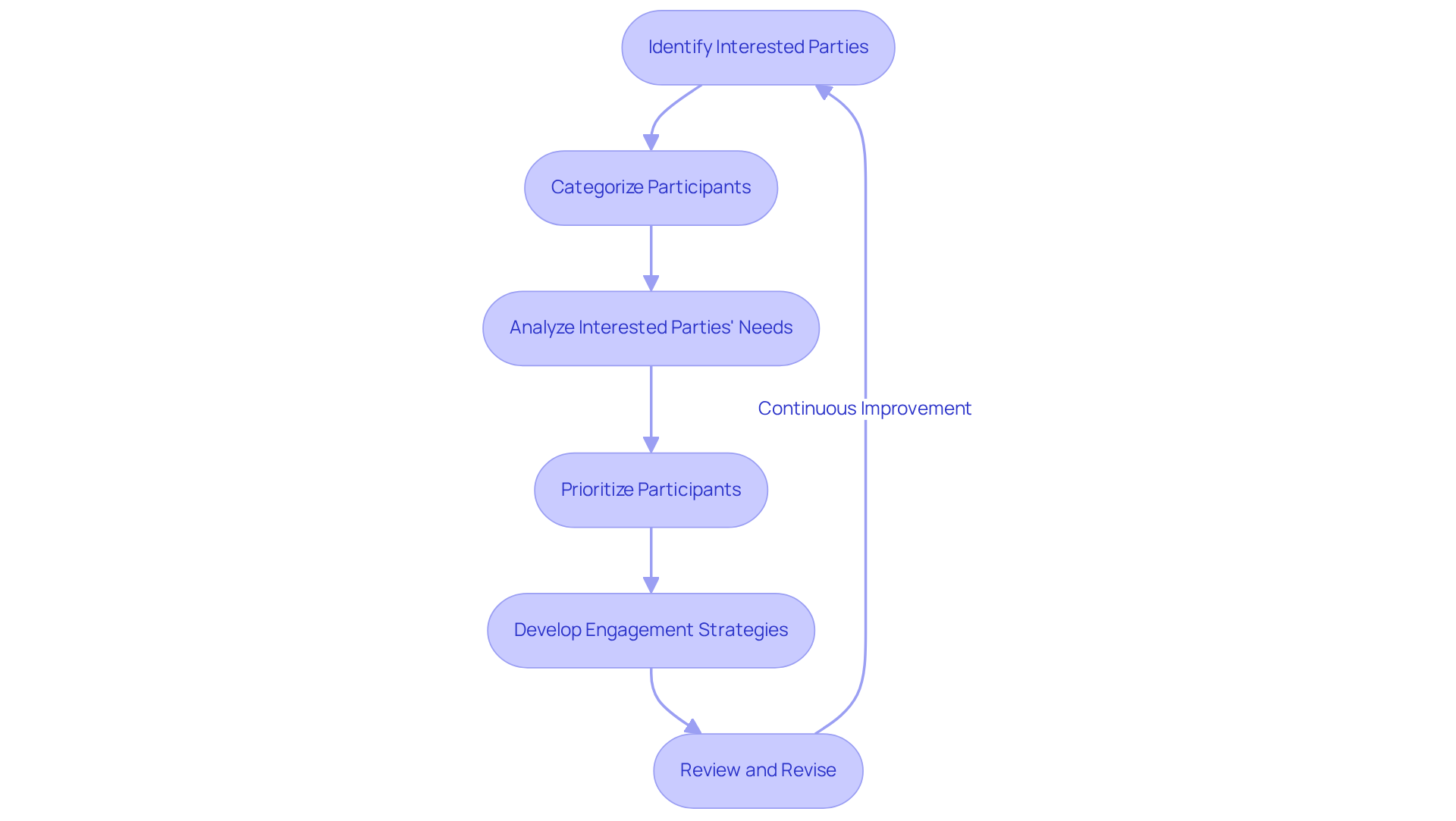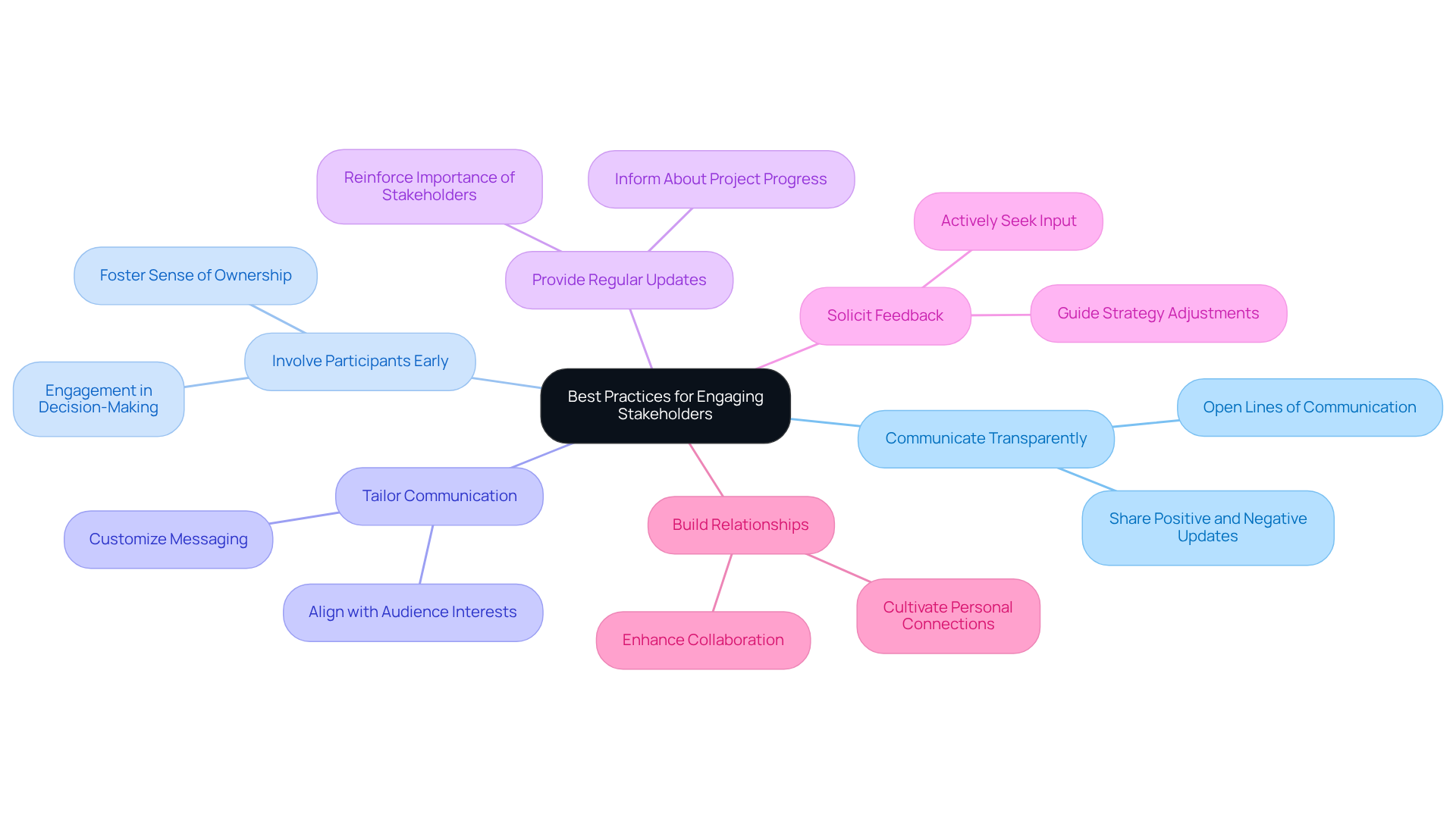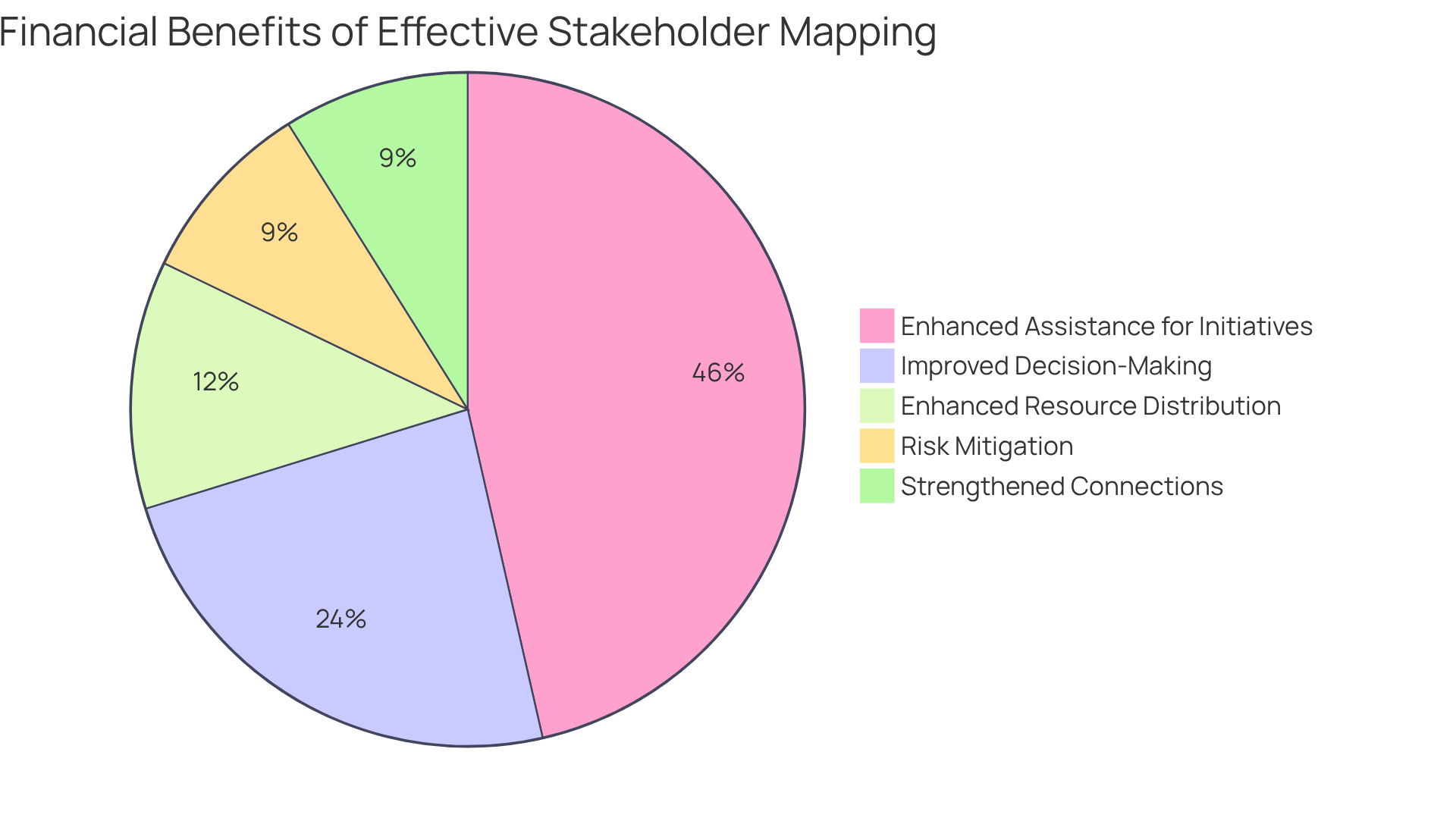Overview
The article delineates four essential practices for effective stakeholder management mapping, pivotal for prioritizing engagement strategies and enhancing communication with influential parties. By identifying, categorizing, analyzing, and developing tailored engagement strategies for stakeholders, organizations can mitigate risks, improve decision-making, and ultimately achieve superior financial outcomes. Research indicates that high stakeholder involvement significantly increases project success rates, underscoring the necessity of these practices. Consequently, organizations are urged to adopt these strategies to ensure robust stakeholder engagement and drive project success.
Introduction
Stakeholder management mapping is crucial for the success of projects and organizations, especially in the financial sector. By identifying and analyzing the various parties that influence or are impacted by a project, businesses can refine their engagement strategies and cultivate stronger relationships. However, the challenge lies in effectively prioritizing these stakeholders and addressing their diverse needs.
What key practices can transform stakeholder mapping from a mere formality into a powerful tool for financial success?
Define Stakeholder Mapping and Its Importance in Financial Management
Stakeholder management mapping is an essential process for identifying and analyzing individuals or groups that have a vested interest in or can influence a project or organization. In the realm of resource management, this method proves crucial, as it enables organizations to understand the interactions among their stakeholders, including investors, creditors, employees, and customers. By effectively using stakeholder management mapping, businesses can prioritize their engagement strategies, ensuring that the most influential parties are addressed appropriately. This proactive approach not only mitigates risks but also enhances communication and trust—elements vital for economic stability and growth.
Consider the case of monetary restructuring: understanding creditors' concerns can lead to more favorable negotiation outcomes, ultimately preserving cash flow and reducing liabilities. Furthermore, a thorough financial evaluation can uncover opportunities to enhance efficiency and diminish risks, underscoring the importance of stakeholder involvement in achieving optimal business performance.

Outline the Steps for Effective Stakeholder Mapping
To effectively map stakeholders in financial projects, follow these essential steps:
- Identify Interested Parties: Begin by brainstorming all potential involved individuals, including both internal and external groups. This foundational step ensures that no critical voices are overlooked.
- Categorize Participants: Classify participants using a power-interest grid, which aids in visualizing their influence and interest levels. This categorization is essential for prioritizing engagement efforts.
- Analyze Interested Parties' Needs: Gain a comprehensive understanding of the specific requirements, expectations, and concerns of each group involved. This insight is crucial for tailoring communication strategies.
- Prioritize Participants: Determine which participants are most essential to your endeavor's success. Focusing on these parties enables targeted interaction strategies that correspond with objectives.
- Develop Engagement Strategies: Create tailored communication and engagement plans for each interest group, ensuring their concerns are addressed effectively. Involving important participants early enhances the chances of success by four times, and organizations that interact with these individuals are 50% more likely to achieve their significant objectives.
- Review and Revise: Regularly revisit and update your interest group map as initiative dynamics evolve. This continuous procedure guarantees lasting alignment and involvement, adjusting to any shifts in participant influence or interest.
Applying these best practices not only strengthens relationships with interested parties but also greatly boosts results. Research indicates that initiatives with robust participant involvement succeed 83% of the time, in contrast to only 32% for those lacking such engagement. As Lucid Software indicates, the purpose of stakeholder management mapping and participant analysis is to enlist key players early on, align involved parties on project goals and plans, and uncover and address conflicts or concerns.

Implement Best Practices for Engaging Stakeholders
To engage stakeholders effectively, consider the following best practices:
-
Communicate Transparently: Establish open lines of communication by sharing both positive and negative updates promptly. This approach fosters trust and demonstrates a commitment to transparency.
-
Involve Participants Early: Engage participants in the decision-making process from the beginning. This inclusion fosters a sense of ownership and commitment, making them more likely to support project initiatives.
-
Tailor Communication: Customize your messaging to align with the interests and concerns of various audience groups. This ensures that communications are pertinent and clear, enhancing understanding and involvement.
-
Provide Regular Updates: Keep interested parties informed about project progress and any changes that may affect them. Regular updates reinforce their importance in the process and help maintain their engagement.
-
Solicit Feedback: Actively seek input from interested parties to gain insights into their perspectives. This feedback can guide adjustments to strategies and enhance overall results.
-
Build Relationships: Invest time in cultivating personal connections with important parties. Strong connections can lead to better collaboration and increased support, ultimately enhancing project success.

Explore the Financial Benefits of Effective Stakeholder Mapping
Effective stakeholder mapping can yield substantial financial benefits, including:
-
Risk Mitigation: By thoroughly grasping the interests of involved parties, organizations can proactively tackle possible challenges, significantly lowering the chance of monetary setbacks. For instance, in the banking industry, effective stakeholder management mapping has shown to result in a 15% decrease in financial losses, underscoring the importance of addressing insights from these stakeholders.
-
Improved decision-making can be achieved through stakeholder management mapping, as knowledgeable participant involvement allows organizations to align their strategies with participant expectations and needs. Our team supports a shortened decision-making cycle throughout the turnaround process, enabling your organization to take decisive action to preserve business health. Research shows that companies with robust engagement strategies are 40% more likely to finish projects on schedule and within budget, illustrating the direct link between involvement and operational success.
-
Enhanced Resource Distribution: Stakeholder management mapping allows for prioritizing interested parties, which enables a more efficient utilization of resources and ensures that efforts are concentrated on the most significant relationships. This strategic emphasis on stakeholder management mapping can lead to a 20% increase in profits, as organizations that engage effectively with interested parties often see improved operational efficiency. Additionally, we continually monitor the success of our plans through our client dashboard, which provides real-time business analytics to diagnose business health and optimize resource allocation.
-
Enhanced Assistance for Initiatives: Stakeholder management mapping indicates that involved parties are more inclined to endorse monetary initiatives, such as funding requests or restructuring plans, resulting in smoother execution. For example, organizations that implement stakeholder management mapping to actively engage interested parties in decision-making processes experience a notable rise in project success rates, with research indicating that high involvement correlates with a 78% success rate in projects.
-
Establishing robust connections with partners through stakeholder management mapping can lead to enduring monetary alliances, providing stability and assistance during difficult periods. Organizations that listen to their stakeholders perform 15% better in their plans, emphasizing the value of fostering these connections for sustained financial health.

Conclusion
Stakeholder management mapping stands as a critical practice that significantly enhances financial management by identifying and analyzing the key individuals and groups influencing or affected by an organization’s initiatives. This process not only prioritizes engagement strategies but also fosters improved communication and trust—essential elements for sustainable growth and economic stability.
The article delineates essential steps for effective stakeholder mapping, including:
- The identification of interested parties
- Categorization based on influence
- The development of tailored engagement strategies
By involving stakeholders early and maintaining transparent communication, organizations can mitigate risks, enhance decision-making, and optimize resource allocation, ultimately resulting in increased project success rates and improved financial performance.
In conclusion, the significance of stakeholder management mapping cannot be overstated. It serves as a strategic tool that aligns organizational objectives with stakeholder expectations while driving financial benefits that stabilize and propel an organization forward. Embracing these best practices will not only fortify stakeholder relationships but also ensure that businesses are well-equipped to navigate challenges and seize opportunities in an ever-evolving landscape.
Frequently Asked Questions
What is stakeholder mapping?
Stakeholder mapping is the process of identifying and analyzing individuals or groups that have a vested interest in or can influence a project or organization.
Why is stakeholder mapping important in financial management?
It is crucial for understanding the interactions among stakeholders, such as investors, creditors, employees, and customers, which helps organizations prioritize engagement strategies and address influential parties appropriately.
How does stakeholder mapping benefit organizations?
It mitigates risks, enhances communication and trust, and is vital for economic stability and growth.
Can you provide an example of stakeholder mapping in action?
In monetary restructuring, understanding creditors' concerns can lead to more favorable negotiation outcomes, preserving cash flow and reducing liabilities.
What additional advantages does stakeholder involvement provide?
Thorough financial evaluations through stakeholder involvement can uncover opportunities to enhance efficiency and diminish risks, contributing to optimal business performance.




